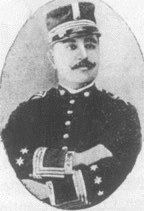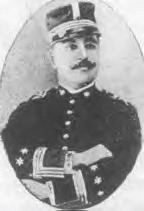Years of service 1882–1898 | Name Angel Mendez Rank Captain Role Writer | |
 | ||
Commands held 3rd Company of the 12th Artillery Battalion at Fort San Cristobal Awards Cruz de la Orden de Merito Militar 1ra Clase destincion Rojo (Order of Military Merit 1st Class) Other work Invented Kola Champagne Died February 23, 1930, Trujillo Alto, Puerto Rico Place of burial Santa Maria Magdalena de Pazzis Cemetery, San Juan, Puerto Rico | ||
Captain Ángel Rivero Méndez (October 2, 1856 – February 23, 1930) was a Puerto Rican soldier, writer, journalist and a businessman who is credited with inventing the "Kola Champagne" soft drink. As a soldier in the Spanish Army, Rivero fired the first shot against the United States in Puerto Rico in the Spanish–American War.
Contents
Early years
Ángel Rivero Méndez was born on October 2, 1856 in Trujillo Alto, Puerto Rico to Juan Rivero and Rosa Méndez, who had immigrated to Puerto Rico from the Canary Islands. Rivero received his secondary education at the "Colegio de Jesuitas" in Santurce (a section of San Juan, the capital of Puerto Rico). After graduation, he enlisted in the Spanish Army and entered the Infantry Academy of Puerto Rico. He was given an officer's commission upon graduation from the Academy on August 2, 1882.

On October 16, 1882, Rivero married Manuela Boneta Babel from San Juan. In 1885, he was accepted in the General Military Academy of Toledo in Spain. There he wrote Toledo, a book about the city of Toledo. In 1886, Rivero was transferred to the Academy of Artillery in Segovia and, on February 28, 1889, he earned a degree in Industrial Engineering.
Military career
On January 1, 1890, Rivero returned to Puerto Rico and was assigned to the 12th Battalion of Plaza. He taught at the Military Preparatory Academy in San Juan and, in 1896, was promoted to the rank of captain. He was active in politics in the ranks of the Unconditional Spanish Party.
As a captain, he was assigned to teach math and chemistry at the Civil Institution of Secondary Education. During this time in his life, he became active in politics as member of the Unconditional Spanish Party. Rivero also founded a newspaper called La Integridad Nacional (The National Integrity), a political paper which represented the views of the party. Rivero, along with some others was expelled from the party and together they formed another political party. An article criticizing the government, written by Rivero, was published and as a consequence, he was arrested and sent to jail. Due to the rumors of war, he was pardoned by Governor Macias and, on March 1, 1898, was assigned the command of the 3rd Company of the 12th Artillery Battalion at Fort San Cristobal in San Juan.
Spanish–American War
When the United States declared war against Spain, the U.S. Navy sent the USS Yale to form a blockade in San Juan Bay. On May 10, 1898, Captain Rivero-Méndez ordered his men to fire upon the Yale, thus becoming the first attack against the Americans in Puerto Rico of Spanish–American War. For his actions, he was awarded the "Cruz de la Orden del Mérito Militar 1ra Clase con Distintivo Rojo" (The Cross of the Order of the Military Merit first class). The residents of San Juan were furious with Rivero and blamed him for the destruction caused to their city by the responding bombardments, however nothing came of those accusations.
Battle of Fajardo
On August 1, the USS Puritan under the command of Captain Frederic W. Rodgers, was sailing by the coastline of the city of Fajardo, when Rogers noticed the "Faro de Las Cabezas de San Juan" (Cape San Juan lighthouse) which was supposed to be the landing site for the US Army in Puerto Rico. Rodgers ordered some of his men ashore, which included Puerto Rican volunteers, with the mission of posting the American Flag atop the lighthouse.
On August 2, three more ships, the USS Amphitrite, USS Leyden, and the USS Hannibal arrived and joined the Puritan. The 25-man Spanish garrison stationed in the city became aware of the American presence and, after notifying their superiors in San Juan, were told to withdraw. When Dr. Santiago Veve Calzada, the mayor of the city, realized that the garrison was gone and that the city was defenseless against the invading Americans, he implored the Spanish authorities in San Juan to dispatch troops to defend his city. Believing that the Spanish forces would not come to his aid, Dr. Santiago Veve Calzada then went to the lighthouse to seek protection for the city from the Americans. On the afternoon of August 3, Dr. Veve Calzada entered the city with a contingent of Marines and the United States flag was hoisted over the Fajardo Customs House and City Hall.
Rivero Méndez was ordered to investigate the situation in Fajardo. He was told that the Americans no longer occupied the city and that it would be an easy task to capture the people of Fajardo who had betrayed Spain. Rivero Méndez passed the information to General Ortega who suggested to General Macías take the town with 200 soldiers and an artillery battery. Macías was told to capture Dr. Veve and all those involved in the revolt, including the Americans in the lighthouse, even it meant the destruction of the lighthouse. Macías refused to accept Ortega's plan.
On August 4, Governor General Macías sent Colonel Pedro del Pino and 200 men to recapture the city. When Colonel Pino entered Fajardo he found it nearly deserted because the residents, fearing a battle, had fled to the Fajardo lighthouse. Pino waited until darkness fell and then ordered his men to attack the lighthouse. The Marines signaled the ships that they were under attack and the ships began to bombard the shore in a protective pattern. The Spanish forces retreated back to the city.
The following day U.S. Marine Lieutenant John A. Lejeune came ashore with a detachment of Marines and evacuated the civilians and Marines for transport to Ponce, and the lighthouse was abandoned. Meanwhile, in the City of Fajardo, Pino’s men tore down the United States flags that flew over the Customs House and City Hall and returned to San Juan after verifying that the lighthouse was abandoned, displaying the flags as his trophies of war. It was the only time that American forces were forced to withdraw from any position during the campaign in Puerto Rico.
End of the conflict
Spain surrendered and Puerto Rico became a possession of the United States as an outcome of the Treaty of Paris of 1898. On October 18, 1898, Rivero-Méndez was ordered to turn over the keys of all the military installations in San Juan to Captain Henry A. Reed of the U.S. Army. Captain Rivero-Méndez was offered a military position by both the American and Spanish governments. He declined both offers and, on April 18, 1899, he officially retired from the Spanish Army.
Kola Champagne
After Rivero retired, he founded the Polo Norte Fabrica de Sodas (North Pole Soda Factory), a soft drink company. Rivero is credited with the invention and elaboration of Kola Champagne, which became, and still is, a popular soft drink in Puerto Rico. Kola Champagne is elaborated and sold in the United States and Mexico by Goya Foods. Inc. Other countries who have also produced the product are Colombia and Jamaica
Author
Rivero dedicated much of his later years to obtaining records and information for a book he ultimately wrote, on the Spanish–American War in Puerto Rico. He also wrote articles for the newspapers El Imparcial, El Mundo and La Correspondencia de Puerto Rico, where he defended Puerto Rican nationalism. In 1922, Rivero published his book Crónica de la Guerra Hispano Americana en Puerto Rico (Chronicles of the Spanish–American War in Puerto Rico), which is considered one of the most complete works written in regard to that military action.
Rivero and his wife were devotees of the Virgin of Lourdes. In 1924, he built a shrine dedicated to the Virgin of Lourdes, on his land in Trujillo Alto. The shrine, which still stands today and is considered an important landmark of the area, was blessed by San Juan's Bishop Jorge Caruana on January 6, 1925.
Death
In the end, Angel Rivero-Méndez suffered from severe depression. On February 23, 1930, he committed suicide by shooting himself in his house in Trujillo Alto, Puerto Rico. His remains are buried in the Santa María Magdalena de Pazzis Cemetery, in San Juan, Puerto Rico.
Military decoration
Military decoration awarded to Rivero Méndez:
